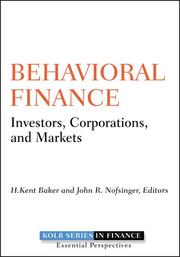Detailansicht
Behavioral Finance
Investors, Corporations, and Markets, Robert W. Kolb Series
ISBN/EAN: 9780470499115
Umbreit-Nr.: 1033314
Sprache:
Englisch
Umfang: 768 S.
Format in cm:
Einband:
gebundenes Buch
Erschienen am 22.10.2010
Auflage: 1/2010
- Zusatztext
- InhaltsangabeBehavioral finance has increasingly become part of mainstream finance--helping to provide explanations for our economic decisions by combining behavioral and cognitive psychological theory with conventional economics and finance. Filled with in-depth insights and practical advice, this reliable resource--part of the Robert W. Kolb Series in Finance--provides a comprehensive view of behavioral finance by discussing the current state of research in this area and detailing its potential impact on investors, corporations, and markets. Comprising contributed chapters by distinguished experts from some of the most influential firms and universities in the world, Behavioral Finance provides a synthesis of the essential elements of this discipline including psychological concepts and behavioral biases; the behavioral aspects of asset pricing, asset allocation, and market prices; investor behavior, corporate managerial behavior, and social influences. Divided into six comprehensive parts, it skillfully: * Describes the fundamental heuristics, cognitive errors, and psychological biases that affect financial decisions * Discusses market inefficiency and behavioral-based pricing models * Explores corporate and executive behavioral finance and examines the behavioral influences involving their investment and financing decisions * Addresses how behavioral finance applies to individual and institutional investors' holdings and their trading endeavors * Shows how cultural factors and societal attitudes affect markets Behavioral Finance contains the latest information from some of the leading practitioners and academics in this field. Engaging and accessible, this book provides a clear understanding of how people make financial decisions and their effects on today's markets.
- Kurztext
- The Robert W. Kolb Series in Finance is an unparalleled source of information dedicated to the most important issues in modern finance. Each book focuses on a specific topic in the field of finance and contains contributed chapters from both respected academics and experienced financial professionals. As part of the Robert W. Kolb Series in Finance, Behavioral Finance aims to provide a comprehensive understanding of the key themes associated with this growing field and how they can be applied to investments, corporations, markets, regulations, and education. Behavioral finance has the potential to explain not only how people make financial decisions and how markets function, but also how to improve them. This book provides invaluable insights into behavioral finance, its psychological foundations, and its applications to finance. Comprising contributed chapters by a distinguished group of academics and practitioners, Behavioral Finance provides a synthesis of the most essential elements of this discipline. It puts behavioral finance in perspective by detailing the current state of research in this area and offers practical guidance on applying the information found here to real-world situations. Behavioral finance has increasingly become part of mainstream finance. If you intend on gaining a better understanding of this discipline, look no further than this book.
- Autorenportrait
- InhaltsangabePART I. FOUNDATION AND KEY CONCEPTS. Chapter 1. Behavioral Finance: An Overview (Kent H. Baker, John R. Nofsinger). Chapter 2. Traditional versus Behavioral Finance (Robert J. Bloomfield). Chapter 3. Behavioral Finance: Application and Pedagogy in Business Education and Training (Rassoul Yazdipour, James A. Howard). Chapter 4. Heuristics (Rules of Thumb) (Hugh Schwartz ). Chapter 5. Neuroeconomics and Neurofinance (Richard L. Peterson). Chapter 6. Emotional Finance (Richard J. Taffler, David A. Tuckett). Chapter 7. Experimental Finance (Robert J. Bloomfield, Alyssa Anderson). Chapter 8. The Psychology of Risk and Uncertainty (Victor Ricciardi). Chapter 9. Psychological Influences on Financial Regulation and Policy (David Hirshleifer, Siew Hong Teoh). PART II. PSYCHOLOGICAL CONCEPTS AND BEHAVIORAL BIASES. Chapter 10. Disposition Effect (Markku Kaustia). Chapter 11. Prospect Theory and Behavioral Biases (Morris Altman). Chapter 12. Cumulative Prospect Theory (Haim Levy). Chapter 13. Overconfidence (Markus Glaser, Martin Weber). Chapter 14. The Representativeness Bias (Richard J. Taffler). Chapter 15. Familiarity Bias (Hisham S. Foad). Chapter 16. Limited Attention (Siew Hong Teoh and Sonya S. Lim). Chapter 17. Other Behavioral Biases (Michael Dowling, Brian M. Lucey). PART III. BEHAVIORAL ASPECTS OF ASSET PRICING. Chapter 18. Market Inefficiency (Raghavendra Rau). Chapter 19. Preference and Belief Based Models (Adam Szyszka). PART IV. BEHAVIORAL CORPORATE FINANCE. Chapter 20. Enterprise Decision Making as Explained in Interview-Based Studies (Hugh Schwartz). Chapter 21. Financing Decisions (Dirk Hackbarth). Chapter 22. Capital Budgeting and Other Investing Decisions (Simon Gervais). Chapter 23. Dividend Policy Decisions (Itzhak (Zahi) Ben-David). Chapter 24. Loyalty, Agency Conflicts and Corporate Governance (Randall K. Morck). Chapter 25. Initial Public Offerings (François Derrien). Chapter 26. Mergers and Acquisitions (Ming Dong). PART V. INVESTOR BEHAVIOR. Chapter 27. Trust Behavior: The Essential Foundation of Financial Markets (Lynn A. Stout). Chapter 28. Individual Investor Trading (Ning Zhu). Chapter 29. Individual Investor Portfolios (Valery Polkovnichenko). Chapter 30. Cognitive Abilities and Financing Decisions (George M Korniotis, Alok Kumar). Chapter 31. Pension Participant Behavior (Julie R. Agnew). Chapter 32. Institutional Investors (Tarun Ramadorai). Chapter 33. Derivative Markets (Peter Locke). PART VI. SOCIAL INFLUENCES. Chapter 34. The Role of Culture and Finance (Rohan Williamson). Chapter 35. Social Interactions and Investing (Mark Seasholes). Chapter 36. Mood (Tyler Shumway). Part VII. Answers to Chapter Discussion Questions. Index.
